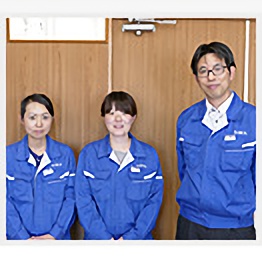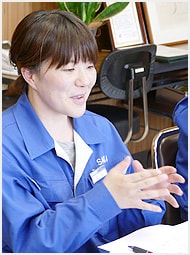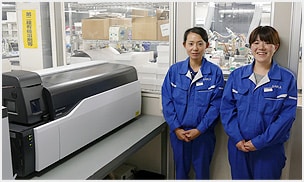LCMS-8050
Analysis of Residual Pesticides in Foods Using the Triple Quad LCMS-8050 and LCMS-8060 Systems

Saika Technological Institute Foundation
-
INDUSTRY
Food and Beverages
-
PAROLA CHIAVE
-
Introduzione a Servizi&Prodotti
LCMS-8050, LCMS-8060
The following is from an interview with Kazuaki Shigefuji, Seika Sada, and Eri Inagaki of the Saika Technological Institute Foundation (SAIKA T.I.F). The SAIKA T.I.F is involved in two operations. One is a public non-profit operation and the other a private for-profit business. One of the for-profit business fields involves contract analysis services specializing in residual pesticide analysis. We asked about how they use their LCMS-8050 and LCMS-8060 systems, given the changing needs of the contract analysis market, and what they would like from Shimadzu.
Customer

Kazuaki Shigefuji, Director (right)
Analysis Service Department
Seika Sada, Manager (center)
Eri Inagaki, Section Head (left)
Saika Technological Institute Foundation
*Le affiliazioni e i titoli dell'intervistato sono aggiornati al momento della stesura del rapporto.
Saika Technological Institute Foundation
Interview
Please tell us about the operations of your foundation?
The foundation was initially established based on a machine invented by our honorary chairman, Keiji Saika, that removed stones from rice. In those days, there was no machine available for separating stones from rice, so stones were often discovered when eating rice. Due to the success of the invention, the foundation was established 53 years ago to give support to technological inventors and help them provide their wonderful inventions to the world. Currently, the foundation is involved in two main areas: public non-profit activities and private for-profit business activities.

Would you tell us more about each of those areas?

In the non-profit area, we are primarily involved in research and development, the results of which are commercialized as a business. We have capabilities for designing and developing machinery and software in-house, obtaining patents and promoting our technology. We also conduct activities that promote invention and creativity in an effort to train future inventors; these include conducting science events or awarding craftworks created as summer vacation homework problems for children from Wakayama Prefecture.
Another major non-profit activity involves the SHOKU-NO-SANJUMARU SELECTION. This activity promotes companies that use ingredients made in Japan and practice eco-friendly manufacturing methods by marking awarded products with a triple-circle symbol that consumers can use to instantly recognize safe and secure food products. We not only review documents, but also perform a strict scientific inspection for residual pesticides, radioactivity, or other factors, to strictly review and recognize products based on our own criteria. Even carefully made products can sometimes not receive the attention they deserve, so we hope our activities help provide a boost.
Products and services in our for-profit operations involve manufacturing and selling machinery and offering residual pesticide analysis services. Machinery manufactured and sold thus far include AGRI SENSOR and CITRUS SENSOR instruments that can non-destructively measure the sugar content and internal damage to apples, oranges, and other fruits and vegetables. In the past, agricultural products were only valued for their external appearance, but after the invention of this machine for analyzing the taste inside, selection criteria have been shifting toward being based on what the consumer thinks tastes good. In addition, our Metal Detector "METARIDDER" offers the industry's highest sensitivity for detecting and removing extremely small metal contaminants from plastic resin pellets and granules.

Lastly, our residual pesticide analysis services offer a high level of expertise due to our specialization in analyzing residual pesticides, which is quite unusual for the contract analysis industry. Since the day we started operations, we have used many Shimadzu GC-MS systems. Due to our long history of specializing in residual pesticide analysis, we now have an extensive wealth of experience and know-how that serves as one of our major strengths.

Ever since it was founded, Saika has been contributing to society through a wide variety of technical capabilities related to research and development.
In that sense, Saika's operations share important similarities to Shimadzu's corporate philosophy "Contributing to Society through Science and Technology."
Thank you for your valuable comments.
Do you mind if we ask you more about your residual pesticide contract analysis services?
We started residual pesticide analysis services in 1998. After the Ministry of Health and Welfare (currently the Ministry of Health, Labour and Welfare) issued a notice regarding rapid analysis the previous year, we started preparations for offering analysis services by developing a method for simultaneously analyzing multiple residual pesticide components. The positive list system (for agricultural chemical residues in foods) came into effect in 2006, and since then, simultaneous multi-component analysis has been widely used throughout the world. According to our investigation, we were the first contract analysis service provider in Japan to offer simultaneous multi-component analysis to general customers. Later, after there was an increased focus on the problem of residual pesticides due to highly publicized food-related incidents, we started offering a variety of services to meet a diversifying array of analytical needs.

Services include a simultaneous multi-component analysis method named MAPS (Multi Analysis of Pesticide-residues by SAIKA), developed independently based on Saika's many years of experience and making improvements to testing methods, and also quick turn-around services named ONEDAY service and FIVEDAY service.
What are some typical needs from your customers?
One major trend, ever since the positive list system started, is a shift from testing mainly raw fruits and vegetables for residual pesticides to testing processed food samples. Some processed food samples contain large amounts of crude drugs, spices, or other contaminant components. Many of our customers perform easier analyses themselves and only ask Saika to analyze difficult samples. There is also a growing trend of customers requiring results quickly, which is increasing the number of requests for our ONEDAY service that delivers results within one business day.
It must be extremely challenging to quickly analyze difficult samples, such as samples that contain a large number of contaminant components. Do you create or review analytical methods for each analysis?
In general, we base analytical methods on our experience analyzing similar samples in the past. We pretreat samples in combination with various clean-up processes, but sometimes that is not enough to eliminate all contaminant components. In such cases, we try to use high instrument performance to avoid any effects from remaining components. With customers increasingly demanding shorter turn-around times, we try to keep the most time-consuming pretreatment processes as simple as possible. Consequently, high instrument performance is required.
What level of instrument performance do you require?

We need high sensitivity, for sure. To minimize the time and trouble involved, we like to simplify pretreatment as much as possible. If the detector is highly selective and highly sensitive, then we can simplify pretreatment and still obtain good results by diluting samples to avoid any effects from contaminant components, even if there are large amounts remaining in the sample. The other thing we need is maintenance frequency that is as low as possible. Performing maintenance means we have to stop our business during that period, so we want instruments that do not need to be cleaned frequently. Also, we need instruments with sensitivity that does not decrease as we are simultaneously analyzing multiple components.
What types of instruments do you currently use?

When we started out, we mainly used GC-MS systems, also in addition to GC and HPLC systems. In those days, GC-MS was required in order to achieve adequate sensitivity for qualitative analysis of pesticides. With the introduction of the triple quad GCMS-TQ8040 system, we can now detect even low concentrations in samples containing many contaminant components, which has been extremely helpful. Consequently, because analysis is less affected by contaminant components, we don't need to reanalyze samples as often, such as by using the NCI mode. Currently, we have three GC-MS/MS systems, which has resulted in more opportunities to analyze samples by GC-MS/MS right from the start. We now use GC-MS to analyze samples expected to contain few contaminant components.
With respect to LC-MS, performance of the instruments themselves was too low at the time we were starting out and we were also uncertain about interface selection, so we mainly used GC-MS. However, once triple quadrupole mass spectrometers with reliable performance became widely available, we have been gradually analyzing more and more items with LC-MS/MS. Currently, we use both systems, because neither system is capable of comprehensively analyzing all items.
Though you have used many Shimadzu instruments in the past, specifically why did you recently choose to purchase the GCMS-TQ8040, LCMS-8050, and LCMS-8060 systems?
The biggest reason is that we have a long history with Shimadzu, ever since we started our analysis department, and Shimadzu offers excellent support capabilities. Shimadzu responds immediately when we need repairs and support from the call center is also very good. If we receive customer samples for a rush order and our instruments break down, we will be in big trouble. However, even in such situations, Shimadzu comes immediately, which impresses me the most.
Another factor is that we can use the same software as for the single-quadrupole and other systems we have been using so far. We also appreciate the Smart Pesticides Database for the GC-MS/MS system and the Residual Pesticides Method Package for the LC-MS/MS system, which allowed us to start analysis immediately after installation. That type of software is very important for getting routine analysis up and running as soon as possible and for minimizing the trouble involved in setting up the condition settings for the extremely large number of components analyzed. To be honest, we were a little worried because we had never used a Shimadzu LC-MS/MS system before, but we were convinced it would be fine once we saw how good the data was from the LCMS-8050 system during the selection process. I think it also provides excellent value in terms of cost versus performance.
What is your impression from actually using the systems?
Recently, customers have been requesting even lower lower-limit-of-quantitation levels. When the positive list system was introduced, requirements were generally based on uniform criteria values, but now customers are gradually asking us to confirm lower and lower concentration levels and to use separate criteria values, so customer needs are definitely changing. Our LCMS-8050 system included the method package, so we were able to get started with analysis smoothly. Later, we introduced the LCMS-8060 system, which we have been using for analysis work that requires additional sensitivity. The LCMS-8050 and LCMS-8060 systems are able to simultaneously analyze large numbers of components without sacrificing sensitivity. Including the GCMS-TQ8040 system, we feel these systems are very well suited to simultaneous analysis of multiple components.

Even though our work often involves analyzing samples with high contaminant levels, the systems have required only minimal maintenance, in contrast to our other systems. The LCMS-8050 and LCMS-8060 have shown no sudden drops or fluctuations in sensitivity and have been operating very reliably. As I mentioned earlier, frequent maintenance interrupts our analysis work, so we really appreciate how low the maintenance requirements are. We were already familiar with operating the software, so that has not been a problem either. Data analysis work for the many components and many samples involved is being accomplished easily as well.
What is your impression of the LC unit in the LC-MS/MS system?
For the LC unit, we chose an UHPLC unit because of how quickly we need to analyze samples. Our existing LC-MS/MS system also includes a Shimadzu LC unit, but we have never had any concerns about contamination. For the newly introduced system, we have been using autosampler pretreatment functions, such as co-injection. To reduce the trouble of replacing columns and mobile phases, we are introducing a system that allows us to set up multiple mobile phases and columns, which we plan to start using soon. Since we need to replace mobile phases and columns so often for qualitative analysis, undoubtedly we will have more and more opportunities to appreciate its convenience once we actually start using the system. Another major benefit is the ability to perform a continuous series of analyses using multiple analysis condition settings without any human intervention.
Thank you.
Lastly, please share any opinions or requests you may have regarding our instruments or Shimadzu.
The contract analysis business for residual pesticides has become very competitive, with a variety of institutions entering the field. Therefore, I think competition will be based on costs and pricing. In the analysis industry, capacity of equipment that can be introduced and analyses that can be accomplished are extremely important factors. In addition to high quality and high performance, equipment will need to offer outstanding cost-effectiveness and productivity. Cutting-edge instruments are great because of their technology, but for our daily operations, it is more important to offer current performance at a low cost. I'm sure that is a difficult challenge, but please do your best.
Thank you for sharing your opinions. We will do our best to provide what you ask for.
Thank you again for providing your valuable time with us today.

Comments About the Interview
In this interview, we asked the SAIKA T.I.F about their operations in general and learned about their extensive technical expertise and deep knowledge. In the residual pesticide contract analysis service business, their success in developing methods for simultaneous multi-component analysis before the key elements of such methods were widely known and the broad menu of services they offer to meet the needs of current markets gave us an appreciation for their impressive technical capabilities and extensive experience as a pioneer in the field. After their use of many Shimadzu instruments since they originally started offering contract analysis services, we are happy to hear that the recently purchased LCMS-8050, LCMS-8060, and GCMS-TQ8040 systems are also operating smoothly. Shimadzu mass spectrometers promoted as the ultra-fast mass spectrometry (UFMS) series offer especially high performance and outstanding simultaneous multi-component analysis capability, making them ideal for the business operated by the SAIKA T.I.F. Shimadzu remains committed to providing the service support necessary to ensure they can continue operating the instruments smoothly. In addition, we will strive to incorporate the opinions they expressed in supplying even better instruments in the future.

LCMS-8050 Liquid Chromatograph Mass Spectrometer



